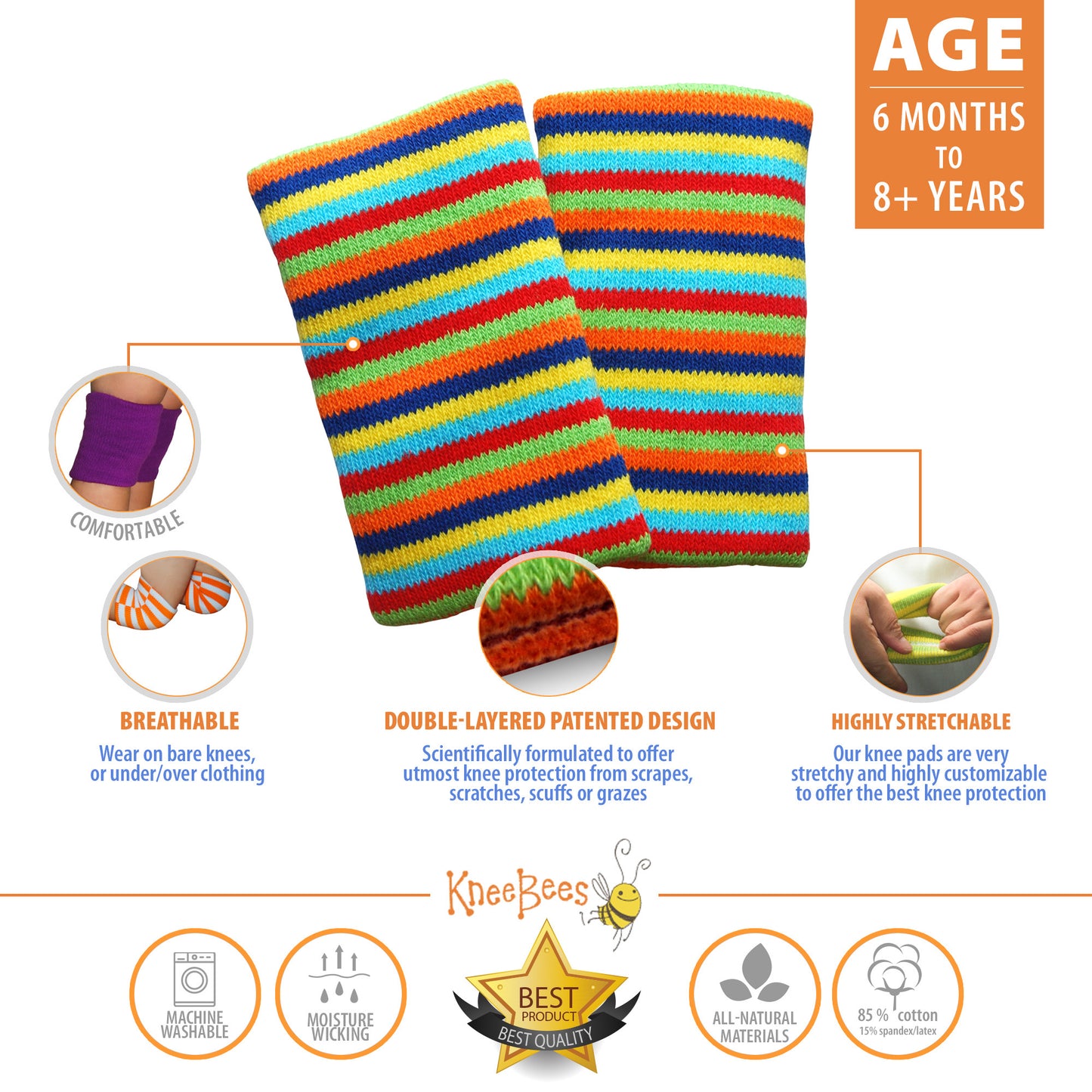 Image taken from www.lifehack.org[/caption]
"How to Raise Kids Who Have Rock-Star Confidence, Even When You Don’t
You want your children to have the confidence to go into the world and live fulfilling lives.
At the same time, you want to protect your children from being hurt.
Could your good intentions to keep your children safe conflict with their development of confidence?
As an experiential educator with over 15 years of experience working with children and adolescents, I offer proven guidelines to help your children gain the confidence to face any challenge.
Where does confidence come from?
The Comfort Zone Model provides the ABC’s of confidence building.
All people have three distinct zones of functioning: The Comfort Zone, The Stretch Zone, and The Panic Zone.
While we all have each of these zones, their boundaries are different for each of us. Additionally, the boundaries of our zones change throughout our lives.
The Comfort Zone
When we are functioning inside the Comfort Zone, we feel safe. Events are predictable. When we get bored, we know how to find the stimulation we’re looking for. We feel special, loved and connected.
The seeds of confidence are sewn in the Comfort Zone because we know exactly how to get our needs met.
No learning happens inside the Comfort Zone because every need is fulfilled by applying what we already know.
The Stretch Zone
Whenever we get uncomfortable, we shift into the Stretch Zone.
While it’s uncertain and scary, the Stretch Zone is the realm of excitement and growth. We learn new information about the world and discover new abilities we didn’t know we had.
Imagine a weightlifter. To increase her strength, she lifts weight frequently. As she does so, the amount of weight she is able to lift changes.
Likewise, the more we venture into our Stretch Zone, it actually changes the size of our Comfort Zone because what was once uncomfortable becomes comfortable. It also expands the size of our Stretch Zone because we learn creative strategies for handling stress without panicking.
The weightlifter must continue lifting weight to maintain her strength. If she stops, she will lose strength and won’t be able to lift the weight she once could.
We must continuously spend time in our Stretch Zones throughout our lives or our Comfort Zone will shrink. Since the boundaries of our Stretch Zone are always changing, we must increase the difficulty of the challenges to feel stretched.
The Panic Zone
If our weightlifter lifts too much weight or she lifts too frequently without giving her muscles time to repair, she will get injured. That injury is like going into the Panic Zone.
There is a thin line that separates the Stretch Zone from the Panic Zone. When the line is crossed, learning and growth stop.
This is trauma. It doesn’t have to be “capital T” trauma. Little traumas, like small muscle tears, still cause damage.
The Panic Zone erodes confidence because the message we teach ourselves here is, “I can’t handle this.”
The Infinite Panic Zone
When people have minimal experiences in the Stretch Zone, they don’t have the opportunities for their Comfort Zone to grow. They are only confident in very limited circumstances.
Additionally, their tolerance for experiences in the Stretch Zone is low. They will quickly shift into the Panic Zone. Their panicked response is very dramatic, which alarms those around them who will then step in to alleviate the panic and reinstate comfort.
This is the pattern of a baby, which is appropriate when we are completely dependent on others to meet our needs for us.
When children or adults spend too much time in the Comfort Zone without adequate time in their Stretch Zone, they will develop an Infinite Panic Zone. When they encounter challenges, they have few strategies to handle these feelings. When they exhaust the few strategies they know, they go into the Panic Zone. Their Infinite Panic Zone keeps them trapped and generates inappropriate responses for their age.
The only way out is to begin expanding their Comfort Zones and Stretch Zones by doing challenging things.
The Picture of Confidence
Confident people have large Comfort Zones that allow them to feel comfortable in a wide variety of circumstances. They also have gained a high tolerance for uncertainty, so their Stretch Zones are fairly deep.
Confident people are fearless, but the circumstances that actually trigger them to go into the Panic Zone are fairly minimal.
People who are the most confident, therefore, are people who have spent extensive amounts of time in the Stretch Zone. Some may have done so because life forced them there. Others may have made strategic choices to do challenging things that would require them to stretch physically, mentally, emotionally, and spiritually. Their experiences have proven to them time and time again that they have the capacity to figure things out and get comfortable with what was once unknown.
How To Expand the Comfort Zone
Expanding the Comfort Zone happens by doing challenging things. By definition, this will make us feel uncomfortable. This discomfort, though, serves a purpose. It moves the boundaries of the Comfort Zone and the Stretch Zone, developing greater confidence and resilience.
This brand of confidence that comes from within, tested by struggle, is the true confidence that allows people to persevere through disaster.
It is clear that to build confident children, we must dare to be uncomfortable.
The Parenting Acrobat Act
Parenting is one the bravest things we can do in our lives.
Basically, your job is to encourage your child to venture onto a tight rope, walking the line between the Stretch and the Panic Zones.
It’s tempting to say in this analogy that the parent is safely on the ground watching the child dangling overhead, but this is not so.
No, you are on a tight rope right next to them, making your own mistakes, too. Neither one of you is on solid ground.
You may feel like fraud at times because you feel just as shaky and unsure as your child does. Know that this is normal.
You don’t need to be the tight rope master to help your child. You just need to actively engage as a fellow student. In fact, seeing yourself as a student, not a master, allows you to empathize with your child and relate to the struggles they face.
Guidelines for Fellow Acrobats
As you bravely accept this challenge, use these guidelines to help your child gain greater confidence:
1. Accept your child’s freedom of choice.
All people have a natural need to grow and learn. Children want to feel proud of themselves and know they can do challenging things.
When we force children to learn before they are ready, we disempower them.
Accepting the child’s choice reinforces their confidence in themselves.
2. Share information to empower your child to make an informed decision.
Share with your children the rationale behind your desire for them to do anything.
Use words and reasons that are appropriate to the child’s age and development. Even small children can process simplified explanations.
3. Learn the signs between your child’s Stretch and Panic Zones.
Know your child’s responses to being stretched. Some of their reactions may be pleasant because some aspects of the Stretch Zone are exciting. Other aspects of the Stretch Zone are frightening, and you will see unflattering behaviors from your child.
When your child is in the Stretch Zone, give space to allow him/her to struggle without feeling judged.
When your child slips into the Panic Zone, reassure safety and acceptance with factual information. Do not to discount their fear.
4. Create an intentional progression of steps for increasing challenge.
Introduce progressive levels of unfamiliarity and discomfort. Create a non-threatening space for the unfamiliar to become familiar and the uncomfortable to become comfortable.
Growth is a process. When you focus on the importance of the process, the outcomes will unfold in their due time.
5. Be the source of calm confidence.
When your child looks at you with fear, it is important not to mirror your own fears back to them.
Offer reassurance by saying, “Nice job! You’re really stretching yourself right now. You are going to be so confident once you get through this. Look how far you’ve come already.”
Regardless of the outcome, praise your child’s effort.
6. Model the skills & behaviors you want for your child.
Playfully challenge your child to test out old skills and take on progressively harder challenges.
Also model intelligent risk management. Ask these questions:
What might happen if we try that?
How much hurt or damage could we cause?
How likely is that?
What can we do to make sure we stay as safe as possible if we try that?
Is what we learn and gain worth the risk?
7. Allow the child to struggle and find solutions.
Like a weightlifting partner, you are there to encourage and ensure that the weightlifter doesn’t get injured, but you don’t lift the weight for her.
Offer advice that has worked for you and honor them if they choose not to try your way. Say, “I have you confidence that you will figure this out.” Recount the solutions that the child used before in similar situations.
8. Thoughtfully process experiences with your child to solidify lessons.
Activity without reflection misses valuable learning opportunities.
Use these questions to help your child learn from challenging experiences:
What do you know now that you didn’t know before?
What was the hardest part? What did you do to get past that part?
Do you feel proud of yourself? What moments do you remember feeling especially proud?
How can what you just learned be helpful in a different situation?
What happens next?
Changing how you parent IS stepping into your Stretch Zone.
At first, you will feel uncomfortable and unsure of yourself. Have faith that you will grow and your Comfort Zone will expand.
Dare to raise children on a tightrope, and you will raise children who are confident.
Raise children who know how to struggle, fail, and get back up again and again.
Raise children who know how to fall flat on their faces and laugh about it without shame.
Raise children who know how to take an unpopular stance because their moral compass points true.
Raise children who are stronger than you, who intimidate you with their aptitude, and who bring you to tears with their compassion."
Image taken from www.lifehack.org[/caption]
"How to Raise Kids Who Have Rock-Star Confidence, Even When You Don’t
You want your children to have the confidence to go into the world and live fulfilling lives.
At the same time, you want to protect your children from being hurt.
Could your good intentions to keep your children safe conflict with their development of confidence?
As an experiential educator with over 15 years of experience working with children and adolescents, I offer proven guidelines to help your children gain the confidence to face any challenge.
Where does confidence come from?
The Comfort Zone Model provides the ABC’s of confidence building.
All people have three distinct zones of functioning: The Comfort Zone, The Stretch Zone, and The Panic Zone.
While we all have each of these zones, their boundaries are different for each of us. Additionally, the boundaries of our zones change throughout our lives.
The Comfort Zone
When we are functioning inside the Comfort Zone, we feel safe. Events are predictable. When we get bored, we know how to find the stimulation we’re looking for. We feel special, loved and connected.
The seeds of confidence are sewn in the Comfort Zone because we know exactly how to get our needs met.
No learning happens inside the Comfort Zone because every need is fulfilled by applying what we already know.
The Stretch Zone
Whenever we get uncomfortable, we shift into the Stretch Zone.
While it’s uncertain and scary, the Stretch Zone is the realm of excitement and growth. We learn new information about the world and discover new abilities we didn’t know we had.
Imagine a weightlifter. To increase her strength, she lifts weight frequently. As she does so, the amount of weight she is able to lift changes.
Likewise, the more we venture into our Stretch Zone, it actually changes the size of our Comfort Zone because what was once uncomfortable becomes comfortable. It also expands the size of our Stretch Zone because we learn creative strategies for handling stress without panicking.
The weightlifter must continue lifting weight to maintain her strength. If she stops, she will lose strength and won’t be able to lift the weight she once could.
We must continuously spend time in our Stretch Zones throughout our lives or our Comfort Zone will shrink. Since the boundaries of our Stretch Zone are always changing, we must increase the difficulty of the challenges to feel stretched.
The Panic Zone
If our weightlifter lifts too much weight or she lifts too frequently without giving her muscles time to repair, she will get injured. That injury is like going into the Panic Zone.
There is a thin line that separates the Stretch Zone from the Panic Zone. When the line is crossed, learning and growth stop.
This is trauma. It doesn’t have to be “capital T” trauma. Little traumas, like small muscle tears, still cause damage.
The Panic Zone erodes confidence because the message we teach ourselves here is, “I can’t handle this.”
The Infinite Panic Zone
When people have minimal experiences in the Stretch Zone, they don’t have the opportunities for their Comfort Zone to grow. They are only confident in very limited circumstances.
Additionally, their tolerance for experiences in the Stretch Zone is low. They will quickly shift into the Panic Zone. Their panicked response is very dramatic, which alarms those around them who will then step in to alleviate the panic and reinstate comfort.
This is the pattern of a baby, which is appropriate when we are completely dependent on others to meet our needs for us.
When children or adults spend too much time in the Comfort Zone without adequate time in their Stretch Zone, they will develop an Infinite Panic Zone. When they encounter challenges, they have few strategies to handle these feelings. When they exhaust the few strategies they know, they go into the Panic Zone. Their Infinite Panic Zone keeps them trapped and generates inappropriate responses for their age.
The only way out is to begin expanding their Comfort Zones and Stretch Zones by doing challenging things.
The Picture of Confidence
Confident people have large Comfort Zones that allow them to feel comfortable in a wide variety of circumstances. They also have gained a high tolerance for uncertainty, so their Stretch Zones are fairly deep.
Confident people are fearless, but the circumstances that actually trigger them to go into the Panic Zone are fairly minimal.
People who are the most confident, therefore, are people who have spent extensive amounts of time in the Stretch Zone. Some may have done so because life forced them there. Others may have made strategic choices to do challenging things that would require them to stretch physically, mentally, emotionally, and spiritually. Their experiences have proven to them time and time again that they have the capacity to figure things out and get comfortable with what was once unknown.
How To Expand the Comfort Zone
Expanding the Comfort Zone happens by doing challenging things. By definition, this will make us feel uncomfortable. This discomfort, though, serves a purpose. It moves the boundaries of the Comfort Zone and the Stretch Zone, developing greater confidence and resilience.
This brand of confidence that comes from within, tested by struggle, is the true confidence that allows people to persevere through disaster.
It is clear that to build confident children, we must dare to be uncomfortable.
The Parenting Acrobat Act
Parenting is one the bravest things we can do in our lives.
Basically, your job is to encourage your child to venture onto a tight rope, walking the line between the Stretch and the Panic Zones.
It’s tempting to say in this analogy that the parent is safely on the ground watching the child dangling overhead, but this is not so.
No, you are on a tight rope right next to them, making your own mistakes, too. Neither one of you is on solid ground.
You may feel like fraud at times because you feel just as shaky and unsure as your child does. Know that this is normal.
You don’t need to be the tight rope master to help your child. You just need to actively engage as a fellow student. In fact, seeing yourself as a student, not a master, allows you to empathize with your child and relate to the struggles they face.
Guidelines for Fellow Acrobats
As you bravely accept this challenge, use these guidelines to help your child gain greater confidence:
1. Accept your child’s freedom of choice.
All people have a natural need to grow and learn. Children want to feel proud of themselves and know they can do challenging things.
When we force children to learn before they are ready, we disempower them.
Accepting the child’s choice reinforces their confidence in themselves.
2. Share information to empower your child to make an informed decision.
Share with your children the rationale behind your desire for them to do anything.
Use words and reasons that are appropriate to the child’s age and development. Even small children can process simplified explanations.
3. Learn the signs between your child’s Stretch and Panic Zones.
Know your child’s responses to being stretched. Some of their reactions may be pleasant because some aspects of the Stretch Zone are exciting. Other aspects of the Stretch Zone are frightening, and you will see unflattering behaviors from your child.
When your child is in the Stretch Zone, give space to allow him/her to struggle without feeling judged.
When your child slips into the Panic Zone, reassure safety and acceptance with factual information. Do not to discount their fear.
4. Create an intentional progression of steps for increasing challenge.
Introduce progressive levels of unfamiliarity and discomfort. Create a non-threatening space for the unfamiliar to become familiar and the uncomfortable to become comfortable.
Growth is a process. When you focus on the importance of the process, the outcomes will unfold in their due time.
5. Be the source of calm confidence.
When your child looks at you with fear, it is important not to mirror your own fears back to them.
Offer reassurance by saying, “Nice job! You’re really stretching yourself right now. You are going to be so confident once you get through this. Look how far you’ve come already.”
Regardless of the outcome, praise your child’s effort.
6. Model the skills & behaviors you want for your child.
Playfully challenge your child to test out old skills and take on progressively harder challenges.
Also model intelligent risk management. Ask these questions:
What might happen if we try that?
How much hurt or damage could we cause?
How likely is that?
What can we do to make sure we stay as safe as possible if we try that?
Is what we learn and gain worth the risk?
7. Allow the child to struggle and find solutions.
Like a weightlifting partner, you are there to encourage and ensure that the weightlifter doesn’t get injured, but you don’t lift the weight for her.
Offer advice that has worked for you and honor them if they choose not to try your way. Say, “I have you confidence that you will figure this out.” Recount the solutions that the child used before in similar situations.
8. Thoughtfully process experiences with your child to solidify lessons.
Activity without reflection misses valuable learning opportunities.
Use these questions to help your child learn from challenging experiences:
What do you know now that you didn’t know before?
What was the hardest part? What did you do to get past that part?
Do you feel proud of yourself? What moments do you remember feeling especially proud?
How can what you just learned be helpful in a different situation?
What happens next?
Changing how you parent IS stepping into your Stretch Zone.
At first, you will feel uncomfortable and unsure of yourself. Have faith that you will grow and your Comfort Zone will expand.
Dare to raise children on a tightrope, and you will raise children who are confident.
Raise children who know how to struggle, fail, and get back up again and again.
Raise children who know how to fall flat on their faces and laugh about it without shame.
Raise children who know how to take an unpopular stance because their moral compass points true.
Raise children who are stronger than you, who intimidate you with their aptitude, and who bring you to tears with their compassion."
Would You Like to Know How to Raise a Self-Confident Child?
Share
We think self - confidence is a crucial trait, without which our children cannot approach the world . We found this wonderful article on www.lifehack.org. Written by Leslie Frey:
[caption id="attachment_1377" align="alignnone" width="300"] Image taken from www.lifehack.org[/caption]
"How to Raise Kids Who Have Rock-Star Confidence, Even When You Don’t
You want your children to have the confidence to go into the world and live fulfilling lives.
At the same time, you want to protect your children from being hurt.
Could your good intentions to keep your children safe conflict with their development of confidence?
As an experiential educator with over 15 years of experience working with children and adolescents, I offer proven guidelines to help your children gain the confidence to face any challenge.
Where does confidence come from?
The Comfort Zone Model provides the ABC’s of confidence building.
All people have three distinct zones of functioning: The Comfort Zone, The Stretch Zone, and The Panic Zone.
While we all have each of these zones, their boundaries are different for each of us. Additionally, the boundaries of our zones change throughout our lives.
The Comfort Zone
When we are functioning inside the Comfort Zone, we feel safe. Events are predictable. When we get bored, we know how to find the stimulation we’re looking for. We feel special, loved and connected.
The seeds of confidence are sewn in the Comfort Zone because we know exactly how to get our needs met.
No learning happens inside the Comfort Zone because every need is fulfilled by applying what we already know.
The Stretch Zone
Whenever we get uncomfortable, we shift into the Stretch Zone.
While it’s uncertain and scary, the Stretch Zone is the realm of excitement and growth. We learn new information about the world and discover new abilities we didn’t know we had.
Imagine a weightlifter. To increase her strength, she lifts weight frequently. As she does so, the amount of weight she is able to lift changes.
Likewise, the more we venture into our Stretch Zone, it actually changes the size of our Comfort Zone because what was once uncomfortable becomes comfortable. It also expands the size of our Stretch Zone because we learn creative strategies for handling stress without panicking.
The weightlifter must continue lifting weight to maintain her strength. If she stops, she will lose strength and won’t be able to lift the weight she once could.
We must continuously spend time in our Stretch Zones throughout our lives or our Comfort Zone will shrink. Since the boundaries of our Stretch Zone are always changing, we must increase the difficulty of the challenges to feel stretched.
The Panic Zone
If our weightlifter lifts too much weight or she lifts too frequently without giving her muscles time to repair, she will get injured. That injury is like going into the Panic Zone.
There is a thin line that separates the Stretch Zone from the Panic Zone. When the line is crossed, learning and growth stop.
This is trauma. It doesn’t have to be “capital T” trauma. Little traumas, like small muscle tears, still cause damage.
The Panic Zone erodes confidence because the message we teach ourselves here is, “I can’t handle this.”
The Infinite Panic Zone
When people have minimal experiences in the Stretch Zone, they don’t have the opportunities for their Comfort Zone to grow. They are only confident in very limited circumstances.
Additionally, their tolerance for experiences in the Stretch Zone is low. They will quickly shift into the Panic Zone. Their panicked response is very dramatic, which alarms those around them who will then step in to alleviate the panic and reinstate comfort.
This is the pattern of a baby, which is appropriate when we are completely dependent on others to meet our needs for us.
When children or adults spend too much time in the Comfort Zone without adequate time in their Stretch Zone, they will develop an Infinite Panic Zone. When they encounter challenges, they have few strategies to handle these feelings. When they exhaust the few strategies they know, they go into the Panic Zone. Their Infinite Panic Zone keeps them trapped and generates inappropriate responses for their age.
The only way out is to begin expanding their Comfort Zones and Stretch Zones by doing challenging things.
The Picture of Confidence
Confident people have large Comfort Zones that allow them to feel comfortable in a wide variety of circumstances. They also have gained a high tolerance for uncertainty, so their Stretch Zones are fairly deep.
Confident people are fearless, but the circumstances that actually trigger them to go into the Panic Zone are fairly minimal.
People who are the most confident, therefore, are people who have spent extensive amounts of time in the Stretch Zone. Some may have done so because life forced them there. Others may have made strategic choices to do challenging things that would require them to stretch physically, mentally, emotionally, and spiritually. Their experiences have proven to them time and time again that they have the capacity to figure things out and get comfortable with what was once unknown.
How To Expand the Comfort Zone
Expanding the Comfort Zone happens by doing challenging things. By definition, this will make us feel uncomfortable. This discomfort, though, serves a purpose. It moves the boundaries of the Comfort Zone and the Stretch Zone, developing greater confidence and resilience.
This brand of confidence that comes from within, tested by struggle, is the true confidence that allows people to persevere through disaster.
It is clear that to build confident children, we must dare to be uncomfortable.
The Parenting Acrobat Act
Parenting is one the bravest things we can do in our lives.
Basically, your job is to encourage your child to venture onto a tight rope, walking the line between the Stretch and the Panic Zones.
It’s tempting to say in this analogy that the parent is safely on the ground watching the child dangling overhead, but this is not so.
No, you are on a tight rope right next to them, making your own mistakes, too. Neither one of you is on solid ground.
You may feel like fraud at times because you feel just as shaky and unsure as your child does. Know that this is normal.
You don’t need to be the tight rope master to help your child. You just need to actively engage as a fellow student. In fact, seeing yourself as a student, not a master, allows you to empathize with your child and relate to the struggles they face.
Guidelines for Fellow Acrobats
As you bravely accept this challenge, use these guidelines to help your child gain greater confidence:
1. Accept your child’s freedom of choice.
All people have a natural need to grow and learn. Children want to feel proud of themselves and know they can do challenging things.
When we force children to learn before they are ready, we disempower them.
Accepting the child’s choice reinforces their confidence in themselves.
2. Share information to empower your child to make an informed decision.
Share with your children the rationale behind your desire for them to do anything.
Use words and reasons that are appropriate to the child’s age and development. Even small children can process simplified explanations.
3. Learn the signs between your child’s Stretch and Panic Zones.
Know your child’s responses to being stretched. Some of their reactions may be pleasant because some aspects of the Stretch Zone are exciting. Other aspects of the Stretch Zone are frightening, and you will see unflattering behaviors from your child.
When your child is in the Stretch Zone, give space to allow him/her to struggle without feeling judged.
When your child slips into the Panic Zone, reassure safety and acceptance with factual information. Do not to discount their fear.
4. Create an intentional progression of steps for increasing challenge.
Introduce progressive levels of unfamiliarity and discomfort. Create a non-threatening space for the unfamiliar to become familiar and the uncomfortable to become comfortable.
Growth is a process. When you focus on the importance of the process, the outcomes will unfold in their due time.
5. Be the source of calm confidence.
When your child looks at you with fear, it is important not to mirror your own fears back to them.
Offer reassurance by saying, “Nice job! You’re really stretching yourself right now. You are going to be so confident once you get through this. Look how far you’ve come already.”
Regardless of the outcome, praise your child’s effort.
6. Model the skills & behaviors you want for your child.
Playfully challenge your child to test out old skills and take on progressively harder challenges.
Also model intelligent risk management. Ask these questions:
What might happen if we try that?
How much hurt or damage could we cause?
How likely is that?
What can we do to make sure we stay as safe as possible if we try that?
Is what we learn and gain worth the risk?
7. Allow the child to struggle and find solutions.
Like a weightlifting partner, you are there to encourage and ensure that the weightlifter doesn’t get injured, but you don’t lift the weight for her.
Offer advice that has worked for you and honor them if they choose not to try your way. Say, “I have you confidence that you will figure this out.” Recount the solutions that the child used before in similar situations.
8. Thoughtfully process experiences with your child to solidify lessons.
Activity without reflection misses valuable learning opportunities.
Use these questions to help your child learn from challenging experiences:
What do you know now that you didn’t know before?
What was the hardest part? What did you do to get past that part?
Do you feel proud of yourself? What moments do you remember feeling especially proud?
How can what you just learned be helpful in a different situation?
What happens next?
Changing how you parent IS stepping into your Stretch Zone.
At first, you will feel uncomfortable and unsure of yourself. Have faith that you will grow and your Comfort Zone will expand.
Dare to raise children on a tightrope, and you will raise children who are confident.
Raise children who know how to struggle, fail, and get back up again and again.
Raise children who know how to fall flat on their faces and laugh about it without shame.
Raise children who know how to take an unpopular stance because their moral compass points true.
Raise children who are stronger than you, who intimidate you with their aptitude, and who bring you to tears with their compassion."
Image taken from www.lifehack.org[/caption]
"How to Raise Kids Who Have Rock-Star Confidence, Even When You Don’t
You want your children to have the confidence to go into the world and live fulfilling lives.
At the same time, you want to protect your children from being hurt.
Could your good intentions to keep your children safe conflict with their development of confidence?
As an experiential educator with over 15 years of experience working with children and adolescents, I offer proven guidelines to help your children gain the confidence to face any challenge.
Where does confidence come from?
The Comfort Zone Model provides the ABC’s of confidence building.
All people have three distinct zones of functioning: The Comfort Zone, The Stretch Zone, and The Panic Zone.
While we all have each of these zones, their boundaries are different for each of us. Additionally, the boundaries of our zones change throughout our lives.
The Comfort Zone
When we are functioning inside the Comfort Zone, we feel safe. Events are predictable. When we get bored, we know how to find the stimulation we’re looking for. We feel special, loved and connected.
The seeds of confidence are sewn in the Comfort Zone because we know exactly how to get our needs met.
No learning happens inside the Comfort Zone because every need is fulfilled by applying what we already know.
The Stretch Zone
Whenever we get uncomfortable, we shift into the Stretch Zone.
While it’s uncertain and scary, the Stretch Zone is the realm of excitement and growth. We learn new information about the world and discover new abilities we didn’t know we had.
Imagine a weightlifter. To increase her strength, she lifts weight frequently. As she does so, the amount of weight she is able to lift changes.
Likewise, the more we venture into our Stretch Zone, it actually changes the size of our Comfort Zone because what was once uncomfortable becomes comfortable. It also expands the size of our Stretch Zone because we learn creative strategies for handling stress without panicking.
The weightlifter must continue lifting weight to maintain her strength. If she stops, she will lose strength and won’t be able to lift the weight she once could.
We must continuously spend time in our Stretch Zones throughout our lives or our Comfort Zone will shrink. Since the boundaries of our Stretch Zone are always changing, we must increase the difficulty of the challenges to feel stretched.
The Panic Zone
If our weightlifter lifts too much weight or she lifts too frequently without giving her muscles time to repair, she will get injured. That injury is like going into the Panic Zone.
There is a thin line that separates the Stretch Zone from the Panic Zone. When the line is crossed, learning and growth stop.
This is trauma. It doesn’t have to be “capital T” trauma. Little traumas, like small muscle tears, still cause damage.
The Panic Zone erodes confidence because the message we teach ourselves here is, “I can’t handle this.”
The Infinite Panic Zone
When people have minimal experiences in the Stretch Zone, they don’t have the opportunities for their Comfort Zone to grow. They are only confident in very limited circumstances.
Additionally, their tolerance for experiences in the Stretch Zone is low. They will quickly shift into the Panic Zone. Their panicked response is very dramatic, which alarms those around them who will then step in to alleviate the panic and reinstate comfort.
This is the pattern of a baby, which is appropriate when we are completely dependent on others to meet our needs for us.
When children or adults spend too much time in the Comfort Zone without adequate time in their Stretch Zone, they will develop an Infinite Panic Zone. When they encounter challenges, they have few strategies to handle these feelings. When they exhaust the few strategies they know, they go into the Panic Zone. Their Infinite Panic Zone keeps them trapped and generates inappropriate responses for their age.
The only way out is to begin expanding their Comfort Zones and Stretch Zones by doing challenging things.
The Picture of Confidence
Confident people have large Comfort Zones that allow them to feel comfortable in a wide variety of circumstances. They also have gained a high tolerance for uncertainty, so their Stretch Zones are fairly deep.
Confident people are fearless, but the circumstances that actually trigger them to go into the Panic Zone are fairly minimal.
People who are the most confident, therefore, are people who have spent extensive amounts of time in the Stretch Zone. Some may have done so because life forced them there. Others may have made strategic choices to do challenging things that would require them to stretch physically, mentally, emotionally, and spiritually. Their experiences have proven to them time and time again that they have the capacity to figure things out and get comfortable with what was once unknown.
How To Expand the Comfort Zone
Expanding the Comfort Zone happens by doing challenging things. By definition, this will make us feel uncomfortable. This discomfort, though, serves a purpose. It moves the boundaries of the Comfort Zone and the Stretch Zone, developing greater confidence and resilience.
This brand of confidence that comes from within, tested by struggle, is the true confidence that allows people to persevere through disaster.
It is clear that to build confident children, we must dare to be uncomfortable.
The Parenting Acrobat Act
Parenting is one the bravest things we can do in our lives.
Basically, your job is to encourage your child to venture onto a tight rope, walking the line between the Stretch and the Panic Zones.
It’s tempting to say in this analogy that the parent is safely on the ground watching the child dangling overhead, but this is not so.
No, you are on a tight rope right next to them, making your own mistakes, too. Neither one of you is on solid ground.
You may feel like fraud at times because you feel just as shaky and unsure as your child does. Know that this is normal.
You don’t need to be the tight rope master to help your child. You just need to actively engage as a fellow student. In fact, seeing yourself as a student, not a master, allows you to empathize with your child and relate to the struggles they face.
Guidelines for Fellow Acrobats
As you bravely accept this challenge, use these guidelines to help your child gain greater confidence:
1. Accept your child’s freedom of choice.
All people have a natural need to grow and learn. Children want to feel proud of themselves and know they can do challenging things.
When we force children to learn before they are ready, we disempower them.
Accepting the child’s choice reinforces their confidence in themselves.
2. Share information to empower your child to make an informed decision.
Share with your children the rationale behind your desire for them to do anything.
Use words and reasons that are appropriate to the child’s age and development. Even small children can process simplified explanations.
3. Learn the signs between your child’s Stretch and Panic Zones.
Know your child’s responses to being stretched. Some of their reactions may be pleasant because some aspects of the Stretch Zone are exciting. Other aspects of the Stretch Zone are frightening, and you will see unflattering behaviors from your child.
When your child is in the Stretch Zone, give space to allow him/her to struggle without feeling judged.
When your child slips into the Panic Zone, reassure safety and acceptance with factual information. Do not to discount their fear.
4. Create an intentional progression of steps for increasing challenge.
Introduce progressive levels of unfamiliarity and discomfort. Create a non-threatening space for the unfamiliar to become familiar and the uncomfortable to become comfortable.
Growth is a process. When you focus on the importance of the process, the outcomes will unfold in their due time.
5. Be the source of calm confidence.
When your child looks at you with fear, it is important not to mirror your own fears back to them.
Offer reassurance by saying, “Nice job! You’re really stretching yourself right now. You are going to be so confident once you get through this. Look how far you’ve come already.”
Regardless of the outcome, praise your child’s effort.
6. Model the skills & behaviors you want for your child.
Playfully challenge your child to test out old skills and take on progressively harder challenges.
Also model intelligent risk management. Ask these questions:
What might happen if we try that?
How much hurt or damage could we cause?
How likely is that?
What can we do to make sure we stay as safe as possible if we try that?
Is what we learn and gain worth the risk?
7. Allow the child to struggle and find solutions.
Like a weightlifting partner, you are there to encourage and ensure that the weightlifter doesn’t get injured, but you don’t lift the weight for her.
Offer advice that has worked for you and honor them if they choose not to try your way. Say, “I have you confidence that you will figure this out.” Recount the solutions that the child used before in similar situations.
8. Thoughtfully process experiences with your child to solidify lessons.
Activity without reflection misses valuable learning opportunities.
Use these questions to help your child learn from challenging experiences:
What do you know now that you didn’t know before?
What was the hardest part? What did you do to get past that part?
Do you feel proud of yourself? What moments do you remember feeling especially proud?
How can what you just learned be helpful in a different situation?
What happens next?
Changing how you parent IS stepping into your Stretch Zone.
At first, you will feel uncomfortable and unsure of yourself. Have faith that you will grow and your Comfort Zone will expand.
Dare to raise children on a tightrope, and you will raise children who are confident.
Raise children who know how to struggle, fail, and get back up again and again.
Raise children who know how to fall flat on their faces and laugh about it without shame.
Raise children who know how to take an unpopular stance because their moral compass points true.
Raise children who are stronger than you, who intimidate you with their aptitude, and who bring you to tears with their compassion."
 Image taken from www.lifehack.org[/caption]
"How to Raise Kids Who Have Rock-Star Confidence, Even When You Don’t
You want your children to have the confidence to go into the world and live fulfilling lives.
At the same time, you want to protect your children from being hurt.
Could your good intentions to keep your children safe conflict with their development of confidence?
As an experiential educator with over 15 years of experience working with children and adolescents, I offer proven guidelines to help your children gain the confidence to face any challenge.
Where does confidence come from?
The Comfort Zone Model provides the ABC’s of confidence building.
All people have three distinct zones of functioning: The Comfort Zone, The Stretch Zone, and The Panic Zone.
While we all have each of these zones, their boundaries are different for each of us. Additionally, the boundaries of our zones change throughout our lives.
The Comfort Zone
When we are functioning inside the Comfort Zone, we feel safe. Events are predictable. When we get bored, we know how to find the stimulation we’re looking for. We feel special, loved and connected.
The seeds of confidence are sewn in the Comfort Zone because we know exactly how to get our needs met.
No learning happens inside the Comfort Zone because every need is fulfilled by applying what we already know.
The Stretch Zone
Whenever we get uncomfortable, we shift into the Stretch Zone.
While it’s uncertain and scary, the Stretch Zone is the realm of excitement and growth. We learn new information about the world and discover new abilities we didn’t know we had.
Imagine a weightlifter. To increase her strength, she lifts weight frequently. As she does so, the amount of weight she is able to lift changes.
Likewise, the more we venture into our Stretch Zone, it actually changes the size of our Comfort Zone because what was once uncomfortable becomes comfortable. It also expands the size of our Stretch Zone because we learn creative strategies for handling stress without panicking.
The weightlifter must continue lifting weight to maintain her strength. If she stops, she will lose strength and won’t be able to lift the weight she once could.
We must continuously spend time in our Stretch Zones throughout our lives or our Comfort Zone will shrink. Since the boundaries of our Stretch Zone are always changing, we must increase the difficulty of the challenges to feel stretched.
The Panic Zone
If our weightlifter lifts too much weight or she lifts too frequently without giving her muscles time to repair, she will get injured. That injury is like going into the Panic Zone.
There is a thin line that separates the Stretch Zone from the Panic Zone. When the line is crossed, learning and growth stop.
This is trauma. It doesn’t have to be “capital T” trauma. Little traumas, like small muscle tears, still cause damage.
The Panic Zone erodes confidence because the message we teach ourselves here is, “I can’t handle this.”
The Infinite Panic Zone
When people have minimal experiences in the Stretch Zone, they don’t have the opportunities for their Comfort Zone to grow. They are only confident in very limited circumstances.
Additionally, their tolerance for experiences in the Stretch Zone is low. They will quickly shift into the Panic Zone. Their panicked response is very dramatic, which alarms those around them who will then step in to alleviate the panic and reinstate comfort.
This is the pattern of a baby, which is appropriate when we are completely dependent on others to meet our needs for us.
When children or adults spend too much time in the Comfort Zone without adequate time in their Stretch Zone, they will develop an Infinite Panic Zone. When they encounter challenges, they have few strategies to handle these feelings. When they exhaust the few strategies they know, they go into the Panic Zone. Their Infinite Panic Zone keeps them trapped and generates inappropriate responses for their age.
The only way out is to begin expanding their Comfort Zones and Stretch Zones by doing challenging things.
The Picture of Confidence
Confident people have large Comfort Zones that allow them to feel comfortable in a wide variety of circumstances. They also have gained a high tolerance for uncertainty, so their Stretch Zones are fairly deep.
Confident people are fearless, but the circumstances that actually trigger them to go into the Panic Zone are fairly minimal.
People who are the most confident, therefore, are people who have spent extensive amounts of time in the Stretch Zone. Some may have done so because life forced them there. Others may have made strategic choices to do challenging things that would require them to stretch physically, mentally, emotionally, and spiritually. Their experiences have proven to them time and time again that they have the capacity to figure things out and get comfortable with what was once unknown.
How To Expand the Comfort Zone
Expanding the Comfort Zone happens by doing challenging things. By definition, this will make us feel uncomfortable. This discomfort, though, serves a purpose. It moves the boundaries of the Comfort Zone and the Stretch Zone, developing greater confidence and resilience.
This brand of confidence that comes from within, tested by struggle, is the true confidence that allows people to persevere through disaster.
It is clear that to build confident children, we must dare to be uncomfortable.
The Parenting Acrobat Act
Parenting is one the bravest things we can do in our lives.
Basically, your job is to encourage your child to venture onto a tight rope, walking the line between the Stretch and the Panic Zones.
It’s tempting to say in this analogy that the parent is safely on the ground watching the child dangling overhead, but this is not so.
No, you are on a tight rope right next to them, making your own mistakes, too. Neither one of you is on solid ground.
You may feel like fraud at times because you feel just as shaky and unsure as your child does. Know that this is normal.
You don’t need to be the tight rope master to help your child. You just need to actively engage as a fellow student. In fact, seeing yourself as a student, not a master, allows you to empathize with your child and relate to the struggles they face.
Guidelines for Fellow Acrobats
As you bravely accept this challenge, use these guidelines to help your child gain greater confidence:
1. Accept your child’s freedom of choice.
All people have a natural need to grow and learn. Children want to feel proud of themselves and know they can do challenging things.
When we force children to learn before they are ready, we disempower them.
Accepting the child’s choice reinforces their confidence in themselves.
2. Share information to empower your child to make an informed decision.
Share with your children the rationale behind your desire for them to do anything.
Use words and reasons that are appropriate to the child’s age and development. Even small children can process simplified explanations.
3. Learn the signs between your child’s Stretch and Panic Zones.
Know your child’s responses to being stretched. Some of their reactions may be pleasant because some aspects of the Stretch Zone are exciting. Other aspects of the Stretch Zone are frightening, and you will see unflattering behaviors from your child.
When your child is in the Stretch Zone, give space to allow him/her to struggle without feeling judged.
When your child slips into the Panic Zone, reassure safety and acceptance with factual information. Do not to discount their fear.
4. Create an intentional progression of steps for increasing challenge.
Introduce progressive levels of unfamiliarity and discomfort. Create a non-threatening space for the unfamiliar to become familiar and the uncomfortable to become comfortable.
Growth is a process. When you focus on the importance of the process, the outcomes will unfold in their due time.
5. Be the source of calm confidence.
When your child looks at you with fear, it is important not to mirror your own fears back to them.
Offer reassurance by saying, “Nice job! You’re really stretching yourself right now. You are going to be so confident once you get through this. Look how far you’ve come already.”
Regardless of the outcome, praise your child’s effort.
6. Model the skills & behaviors you want for your child.
Playfully challenge your child to test out old skills and take on progressively harder challenges.
Also model intelligent risk management. Ask these questions:
What might happen if we try that?
How much hurt or damage could we cause?
How likely is that?
What can we do to make sure we stay as safe as possible if we try that?
Is what we learn and gain worth the risk?
7. Allow the child to struggle and find solutions.
Like a weightlifting partner, you are there to encourage and ensure that the weightlifter doesn’t get injured, but you don’t lift the weight for her.
Offer advice that has worked for you and honor them if they choose not to try your way. Say, “I have you confidence that you will figure this out.” Recount the solutions that the child used before in similar situations.
8. Thoughtfully process experiences with your child to solidify lessons.
Activity without reflection misses valuable learning opportunities.
Use these questions to help your child learn from challenging experiences:
What do you know now that you didn’t know before?
What was the hardest part? What did you do to get past that part?
Do you feel proud of yourself? What moments do you remember feeling especially proud?
How can what you just learned be helpful in a different situation?
What happens next?
Changing how you parent IS stepping into your Stretch Zone.
At first, you will feel uncomfortable and unsure of yourself. Have faith that you will grow and your Comfort Zone will expand.
Dare to raise children on a tightrope, and you will raise children who are confident.
Raise children who know how to struggle, fail, and get back up again and again.
Raise children who know how to fall flat on their faces and laugh about it without shame.
Raise children who know how to take an unpopular stance because their moral compass points true.
Raise children who are stronger than you, who intimidate you with their aptitude, and who bring you to tears with their compassion."
Image taken from www.lifehack.org[/caption]
"How to Raise Kids Who Have Rock-Star Confidence, Even When You Don’t
You want your children to have the confidence to go into the world and live fulfilling lives.
At the same time, you want to protect your children from being hurt.
Could your good intentions to keep your children safe conflict with their development of confidence?
As an experiential educator with over 15 years of experience working with children and adolescents, I offer proven guidelines to help your children gain the confidence to face any challenge.
Where does confidence come from?
The Comfort Zone Model provides the ABC’s of confidence building.
All people have three distinct zones of functioning: The Comfort Zone, The Stretch Zone, and The Panic Zone.
While we all have each of these zones, their boundaries are different for each of us. Additionally, the boundaries of our zones change throughout our lives.
The Comfort Zone
When we are functioning inside the Comfort Zone, we feel safe. Events are predictable. When we get bored, we know how to find the stimulation we’re looking for. We feel special, loved and connected.
The seeds of confidence are sewn in the Comfort Zone because we know exactly how to get our needs met.
No learning happens inside the Comfort Zone because every need is fulfilled by applying what we already know.
The Stretch Zone
Whenever we get uncomfortable, we shift into the Stretch Zone.
While it’s uncertain and scary, the Stretch Zone is the realm of excitement and growth. We learn new information about the world and discover new abilities we didn’t know we had.
Imagine a weightlifter. To increase her strength, she lifts weight frequently. As she does so, the amount of weight she is able to lift changes.
Likewise, the more we venture into our Stretch Zone, it actually changes the size of our Comfort Zone because what was once uncomfortable becomes comfortable. It also expands the size of our Stretch Zone because we learn creative strategies for handling stress without panicking.
The weightlifter must continue lifting weight to maintain her strength. If she stops, she will lose strength and won’t be able to lift the weight she once could.
We must continuously spend time in our Stretch Zones throughout our lives or our Comfort Zone will shrink. Since the boundaries of our Stretch Zone are always changing, we must increase the difficulty of the challenges to feel stretched.
The Panic Zone
If our weightlifter lifts too much weight or she lifts too frequently without giving her muscles time to repair, she will get injured. That injury is like going into the Panic Zone.
There is a thin line that separates the Stretch Zone from the Panic Zone. When the line is crossed, learning and growth stop.
This is trauma. It doesn’t have to be “capital T” trauma. Little traumas, like small muscle tears, still cause damage.
The Panic Zone erodes confidence because the message we teach ourselves here is, “I can’t handle this.”
The Infinite Panic Zone
When people have minimal experiences in the Stretch Zone, they don’t have the opportunities for their Comfort Zone to grow. They are only confident in very limited circumstances.
Additionally, their tolerance for experiences in the Stretch Zone is low. They will quickly shift into the Panic Zone. Their panicked response is very dramatic, which alarms those around them who will then step in to alleviate the panic and reinstate comfort.
This is the pattern of a baby, which is appropriate when we are completely dependent on others to meet our needs for us.
When children or adults spend too much time in the Comfort Zone without adequate time in their Stretch Zone, they will develop an Infinite Panic Zone. When they encounter challenges, they have few strategies to handle these feelings. When they exhaust the few strategies they know, they go into the Panic Zone. Their Infinite Panic Zone keeps them trapped and generates inappropriate responses for their age.
The only way out is to begin expanding their Comfort Zones and Stretch Zones by doing challenging things.
The Picture of Confidence
Confident people have large Comfort Zones that allow them to feel comfortable in a wide variety of circumstances. They also have gained a high tolerance for uncertainty, so their Stretch Zones are fairly deep.
Confident people are fearless, but the circumstances that actually trigger them to go into the Panic Zone are fairly minimal.
People who are the most confident, therefore, are people who have spent extensive amounts of time in the Stretch Zone. Some may have done so because life forced them there. Others may have made strategic choices to do challenging things that would require them to stretch physically, mentally, emotionally, and spiritually. Their experiences have proven to them time and time again that they have the capacity to figure things out and get comfortable with what was once unknown.
How To Expand the Comfort Zone
Expanding the Comfort Zone happens by doing challenging things. By definition, this will make us feel uncomfortable. This discomfort, though, serves a purpose. It moves the boundaries of the Comfort Zone and the Stretch Zone, developing greater confidence and resilience.
This brand of confidence that comes from within, tested by struggle, is the true confidence that allows people to persevere through disaster.
It is clear that to build confident children, we must dare to be uncomfortable.
The Parenting Acrobat Act
Parenting is one the bravest things we can do in our lives.
Basically, your job is to encourage your child to venture onto a tight rope, walking the line between the Stretch and the Panic Zones.
It’s tempting to say in this analogy that the parent is safely on the ground watching the child dangling overhead, but this is not so.
No, you are on a tight rope right next to them, making your own mistakes, too. Neither one of you is on solid ground.
You may feel like fraud at times because you feel just as shaky and unsure as your child does. Know that this is normal.
You don’t need to be the tight rope master to help your child. You just need to actively engage as a fellow student. In fact, seeing yourself as a student, not a master, allows you to empathize with your child and relate to the struggles they face.
Guidelines for Fellow Acrobats
As you bravely accept this challenge, use these guidelines to help your child gain greater confidence:
1. Accept your child’s freedom of choice.
All people have a natural need to grow and learn. Children want to feel proud of themselves and know they can do challenging things.
When we force children to learn before they are ready, we disempower them.
Accepting the child’s choice reinforces their confidence in themselves.
2. Share information to empower your child to make an informed decision.
Share with your children the rationale behind your desire for them to do anything.
Use words and reasons that are appropriate to the child’s age and development. Even small children can process simplified explanations.
3. Learn the signs between your child’s Stretch and Panic Zones.
Know your child’s responses to being stretched. Some of their reactions may be pleasant because some aspects of the Stretch Zone are exciting. Other aspects of the Stretch Zone are frightening, and you will see unflattering behaviors from your child.
When your child is in the Stretch Zone, give space to allow him/her to struggle without feeling judged.
When your child slips into the Panic Zone, reassure safety and acceptance with factual information. Do not to discount their fear.
4. Create an intentional progression of steps for increasing challenge.
Introduce progressive levels of unfamiliarity and discomfort. Create a non-threatening space for the unfamiliar to become familiar and the uncomfortable to become comfortable.
Growth is a process. When you focus on the importance of the process, the outcomes will unfold in their due time.
5. Be the source of calm confidence.
When your child looks at you with fear, it is important not to mirror your own fears back to them.
Offer reassurance by saying, “Nice job! You’re really stretching yourself right now. You are going to be so confident once you get through this. Look how far you’ve come already.”
Regardless of the outcome, praise your child’s effort.
6. Model the skills & behaviors you want for your child.
Playfully challenge your child to test out old skills and take on progressively harder challenges.
Also model intelligent risk management. Ask these questions:
What might happen if we try that?
How much hurt or damage could we cause?
How likely is that?
What can we do to make sure we stay as safe as possible if we try that?
Is what we learn and gain worth the risk?
7. Allow the child to struggle and find solutions.
Like a weightlifting partner, you are there to encourage and ensure that the weightlifter doesn’t get injured, but you don’t lift the weight for her.
Offer advice that has worked for you and honor them if they choose not to try your way. Say, “I have you confidence that you will figure this out.” Recount the solutions that the child used before in similar situations.
8. Thoughtfully process experiences with your child to solidify lessons.
Activity without reflection misses valuable learning opportunities.
Use these questions to help your child learn from challenging experiences:
What do you know now that you didn’t know before?
What was the hardest part? What did you do to get past that part?
Do you feel proud of yourself? What moments do you remember feeling especially proud?
How can what you just learned be helpful in a different situation?
What happens next?
Changing how you parent IS stepping into your Stretch Zone.
At first, you will feel uncomfortable and unsure of yourself. Have faith that you will grow and your Comfort Zone will expand.
Dare to raise children on a tightrope, and you will raise children who are confident.
Raise children who know how to struggle, fail, and get back up again and again.
Raise children who know how to fall flat on their faces and laugh about it without shame.
Raise children who know how to take an unpopular stance because their moral compass points true.
Raise children who are stronger than you, who intimidate you with their aptitude, and who bring you to tears with their compassion."


























